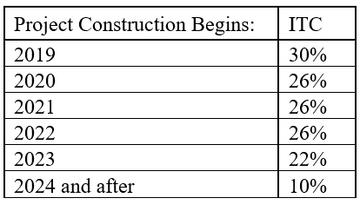Energy Policy and the Growth of Sustainable Energy
Quite a bit of new policy related to the renewable energy industry has been introduced since the end of 2020. On December 27, 2020, the Consolidated Appropriations Act 2021 was passed by Congress and signed into law. A part of that legislation, the bipartisan Energy Act of 2020 implemented an extension of key renewable energy tax credits, including the investment tax credit (ITC). The ITC had already begun “sunsetting” and decreased from 30% to 26% on January 1, 2020. It had been scheduled to decrease again on January 1, 2021 to 22%, but instead the 2020 ITC level was extended through 2022. The current outlook is as follows:

Despite the onset of a global pandemic and an economic recession in 2020, states, cities, utilities, and businesses continued to announce or pursue decarbonization plans. Even with the challenges, clean energy demand in the US proved resilient as renewable and storage technologies recorded declining costs and rising capacity and usage factors. Renewables edged out other electricity generation sources as electric demand fell during the year. As of early December 2020, the share of renewables exceeded that of coal in generation for 153 days compared with only 39 days in 2019.
Renewable energy growth may accelerate further in 2021 as the new administration starts to execute on a platform to achieve net-zero carbon emissions by 2050. Since taking office on January 20, 2021, the Biden Administration has introduced several Executive Orders related to climate change including two issued on January 27th, Climate Day. While these orders provide early indicators of the Biden administration’s commitment to renewable energy development and deployment, the overarching goals and steps necessary to achieve them will be challenging. Accomplishing the core climate policy objectives will require legislation that is far from certain in a highly divided Congress. Though Biden does have the power to direct federal agencies on his own, much of the spending that may come with those directives will rely on Congressional approval.
Regardless of what happens in Washington, the US business community—as well as most local and state governments—are already moving aggressively to adopt sustainable energy objectives and technologies. Federal energy policy will undoubtedly continue to progress the development and deployment of sustainable energy solutions; however, local decisions will determine the pace of progress. Better economics, new and improved technology, and societal pressure together are driving the transition to a low-carbon energy future.
Energy efficiency remains one the key elements of low-carbon transition strategies. Reducing energy consumption is the simplest and most direct method of decreasing costs and carbon emissions. Such measures have resulted in lower energy intensity even amid economic growth. In the United States, for instance, GDP expanded by 25% over the past decade, while primary energy demand grew only by 6.6%. Policies geared toward energy efficiency have motivated utilities across the United States to implement energy efficiency measures and tracking. Following suit, corporations have increased monitoring of energy usage, upgraded key equipment, and installed building automation systems to control lighting and HVAC systems. Some companies are now going even further. In 2019, Carrier’s Florida headquarters became the first commercial building in the state to receive Leadership in Energy and Environmental Design (LEED) platinum v4 certification. (Read about it here.) In addition, Carrier has instituted regular tracking of estimated greenhouse gas emissions avoided at customer sites around the world by installing high-efficiency HVAC and refrigeration systems.

Due to the shifts in market and consumer expectations, sustainability is becoming more closely tied to organizational brand image. As early as 2018, more than 90 percent of CEOs stated that sustainability is important to their company’s success. According to the Nielsen Sustainability Imperative, 3 in 4 Millennials and Gen Zs are willing to pay extra for sustainable product offerings. Corporate sustainability strategies now include marketing sustainable products and services, creating positions such as chief sustainability officer, and publishing sustainability reports for consumers, investors, activists, and the public at large.
This trend is not likely to abate anytime soon, either. Surveys show that 88% of business school students think that learning about social and environmental issues in business is a priority, and 67% want to incorporate environmental sustainability into their future jobs. With an incoming workforce that prioritizes corporate social and environmental responsibility, organizations will need to implement actionable sustainability objectives in order to attract top talent. Furthermore, coupled with a market that has incrementally shifted towards embracing environmental sustainability, it has become more costly for businesses to ignore or forego greener resource options and risk overlooking potential customers.
Energy efficiency and sustainable energy are the future. The medium to longer-term commitments to reducing carbon emissions currently driving the energy transition is unlikely to dissipate, particularly in areas where considerable momentum has already been gained. It will likely be further enabled by technology innovation, policy frameworks, and market forces. Efficiency and cost improvement across several storage technologies will eliminate intermittency issues, one of few flaws in renewable generation. The result will be commercial and industrial customers that are less reliant on fossil fuels, and a much more decentralized energy system with local small-scale generation that complements the historical centralized energy system. Add a bonus of increased resiliency by deploying energy resources directly on your property and the future is truly bright.
Sources in order of appearance:
Motyka, Marlene. Deloitte. 2021 Renewable Energy Industry Outlook. https://www2.deloitte.com/us/en/pages/energy-and-resources/articles/renewable-energy-outlook.html
Harden, Kate; Porter, Stanley. Deloitte. Navigating the energy transition from disruption to growth. May 27, 2020. https://www2.deloitte.com/us/en/insights/industry/power-and-utilities/future-of-energy-us-energy-transition.html
Hoffman, Andrew. Stanford Social Innovation Review. The Next Phase of Business Sustainability. Spring 2018. https://ssir.org/articles/entry/the_next_phase_of_business_sustainability#
Nielson. The Sustainability Imperative. October 2015. https://www.nielsen.com/wp-content/uploads/sites/3/2019/04/Global20Sustainability20Report_October202015.pdf
